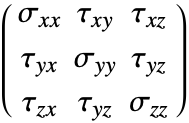SolidMechanicsStress[vars,pars,strain]
yields solid mechanics internal stress with variables vars, parameters pars and total strain strain.
SolidMechanicsStress[vars,pars,strain,displacement]
yields solid mechanics stress for nonlinear material laws.


SolidMechanicsStress
SolidMechanicsStress[vars,pars,strain]
yields solid mechanics internal stress with variables vars, parameters pars and total strain strain.
SolidMechanicsStress[vars,pars,strain,displacement]
yields solid mechanics stress for nonlinear material laws.
Details


- SolidMechanicsStress returns the mechanical stress from a given total strain with dependent variables of displacement
 ,
,  and
and  in units of
in units of  , independent variables
, independent variables  in
in  and time variable
and time variable  in units of
in units of  .
. - Stress is a resistance force per cross-sectional area
 .
. - Stresses have the unit of
 .
. - SolidMechanicsStress uses the same variables vars specification as SolidMechanicsPDEComponent.
- SolidMechanicsStress uses the same parameter pars specification as SolidMechanicsPDEComponent.
- A SymmetrizedArray specifies strain.
- Typically, strain is the result of SolidMechanicsStrain.
- For elastic materials, SolidMechanicsStress uses the elastic strain
 to compute the stress:
to compute the stress: - SolidMechanicsStress subtracts inelastic strains
 such as thermal or initial strains from the given total strain
such as thermal or initial strains from the given total strain  .
. - SolidMechanicsStress returns a SymmetrizedArray of stresses of the form:
- The
 represent the normal stresses and
represent the normal stresses and  represent the shear stresses.
represent the shear stresses. - Cauchy stress is the default output stress computed.
- The following stresses can be computed by specifying "OutputStressMeasure":
-
"FirstPiolaKirchhoff" First Piola-Kirchhoff stress "SecondPiolaKirchhoff" Second Piola-Kirchhoff stress "Cauchy" Cauchy stress "Kirchhoff" Kirchhoff stress - SolidMechanicsStress computes the internal stress
 :
: - An initial stress
 can be specified for SolidMechanicsPDEComponent with the "InitialStress" parameter.
can be specified for SolidMechanicsPDEComponent with the "InitialStress" parameter. - For nonlinear materials, SolidMechanicsStress uses the total strain and displacement to compute the stress.

Examples
open all close allScope (5)
Stationary Analysis (1)
Stationary Plane Stress Analysis (1)
Compute a plane stress case as an extended model. This allows for the computation of the out-of-plane strain and verifies that the out-of-plane stress is 0. A rectangular steel plate is held fixed at the left and with a forced displacement on the right. Set up the region, variables and parameters. The variables now include all three directions:
Solve the equations with three semi-dependent variables:
Note that now there are three output variables in the list of displacements. Visualize the displacement for the main variables:
Note that the strain is a 3×3 array. Visualize the out-of-plane strain:
Compute the stress from the strain:
Note that the stress is a 3×3 array. Verify the plane stress condition:
Stationary Plane Strain Analysis (1)
Compute a plane strain case as an extended model. This allows for the computation of the out-of-plane stress and verifies that the out-of-plane strain is 0. Set up the region, variables and parameters. The variables now include all three directions:
Set up the solid mechanics PDE component:
Compute the strains from the displacements:
Note that the strain is a 3×3 array. Verify the plane strain condition:
Compute the stress from the strain:
Note that the stress is a 3×3 array. Visualize the out-of-plane stress:
Stationary Hyperelastic Plane Stress Analysis (1)
Possible Issues (1)
In the axisymmetric case, it is important that the displacements specified are functions of the spatial coordinates. To illustrate why, create variables, parameters and displacement functions that are not functions of space:
Note that the generated InterpolatingFunction is not a function of the spatial coordinates ![]() and
and ![]() . Now when the strain and stress are computed, it can be seen that in the stress tensor, some interpolating functions also appear without the spatial coordinates:
. Now when the strain and stress are computed, it can be seen that in the stress tensor, some interpolating functions also appear without the spatial coordinates:
This is because in the formula for the axisymmetric case, the ![]() component of the strain is computed as
component of the strain is computed as ![]() , where
, where ![]() is the first dependent variable and
is the first dependent variable and ![]() the radial direction in the cylindrical coordinate system. The derivation is given in the section Axisymmetric Models. When the stress is computed from the strains, the value for
the radial direction in the cylindrical coordinate system. The derivation is given in the section Axisymmetric Models. When the stress is computed from the strains, the value for ![]() is taken from the first given displacement function, usol in this case. If that function does not depend on the independent variables
is taken from the first given displacement function, usol in this case. If that function does not depend on the independent variables ![]() and
and ![]() , then they cannot appear in the output.
, then they cannot appear in the output.
To avoid this, the spatial coordinates ![]() and
and ![]() need to be used in the displacements:
need to be used in the displacements:
Now all InterpolatingFunction components of the stress tensor make use of the spatial coordinates:
Tech Notes
Related Guides
Text
Wolfram Research (2021), SolidMechanicsStress, Wolfram Language function, https://reference.wolfram.com/language/ref/SolidMechanicsStress.html (updated 2025).
CMS
Wolfram Language. 2021. "SolidMechanicsStress." Wolfram Language & System Documentation Center. Wolfram Research. Last Modified 2025. https://reference.wolfram.com/language/ref/SolidMechanicsStress.html.
APA
Wolfram Language. (2021). SolidMechanicsStress. Wolfram Language & System Documentation Center. Retrieved from https://reference.wolfram.com/language/ref/SolidMechanicsStress.html
BibTeX
@misc{reference.wolfram_2025_solidmechanicsstress, author="Wolfram Research", title="{SolidMechanicsStress}", year="2025", howpublished="\url{https://reference.wolfram.com/language/ref/SolidMechanicsStress.html}", note=[Accessed: 21-December-2025]}
BibLaTeX
@online{reference.wolfram_2025_solidmechanicsstress, organization={Wolfram Research}, title={SolidMechanicsStress}, year={2025}, url={https://reference.wolfram.com/language/ref/SolidMechanicsStress.html}, note=[Accessed: 21-December-2025]}